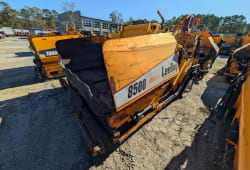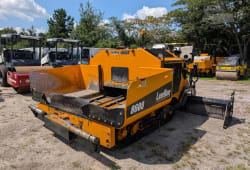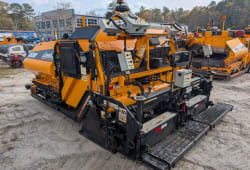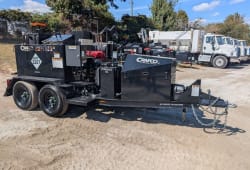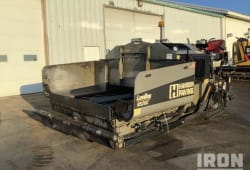Best Practices Using Differential Locks in Heavy Equipment
12 Min read
)
November 28, 2023
Differential locks are an essential component of heavy equipment, providing increased traction and improved safety measures. By understanding the function and key components of differential locks, as well as following best practices for their usage, operators can optimize their heavy equipment performance. Additionally, being aware of common differential lock issues and future trends in differential lock technology can help operators troubleshoot problems and stay up-to-date with industry advancements.
Differential locks play a crucial role in heavy equipment, allowing both wheels on an axle to rotate at the same speed. This ensures that optimal traction is maintained even when one wheel loses traction, preventing slippage and enhancing overall performance. Without differential locks, power would be transferred to the wheel with the least resistance, compromising the machine's ability to overcome challenging terrain.
The Function of Differential Locks in Heavy Equipment
Differential locks work by preventing the differential gears from allowing one wheel to rotate freely while the other wheel is stationary. When engaged, the differential lock forces both wheels on an axle to rotate together, distributing power evenly. This feature is particularly useful in situations where one wheel encounters a slippery surface, ensuring that power is equally distributed to both wheels for maximum traction.
Imagine a scenario where a heavy-duty construction vehicle is navigating through a muddy construction site. As the vehicle moves forward, one of its wheels hits a particularly slippery patch of mud. Without a differential lock, the wheel with less traction would spin freely, while the other wheel, with better traction, would remain stationary. This would result in an uneven distribution of power, causing the vehicle to lose momentum and potentially get stuck. However, with the differential lock engaged, both wheels would rotate together, allowing the vehicle to maintain traction and continue moving forward with ease.
Furthermore, differential locks are not only beneficial in off-road situations but also in everyday operations. For example, when a heavy equipment operator needs to make tight turns, the inside wheel tends to rotate slower than the outside wheel due to the difference in the turning radius. By engaging the differential lock, both wheels are forced to rotate at the same speed, preventing unnecessary strain on the drivetrain and ensuring a smooth and efficient turn.
Key Components of Differential Locks
The differential locks in heavy equipment consist of various components, including the lock assembly, solenoids, and control systems. The lock assembly comprises mechanical mechanisms that engage and disengage the lock, enabling operators to activate the differential lock when needed. Solenoids control the engagement process, while control systems provide operators with the ability to monitor and adjust differential lock settings based on the terrain and operating conditions.
Modern heavy equipment often utilizes advanced electronic control systems to enhance the functionality and effectiveness of differential locks. These control systems incorporate sensors that detect wheel slippage and automatically engage the differential lock when needed. This automation not only simplifies the operation for the equipment operator but also ensures that the differential lock is engaged at the precise moment to maximize traction and prevent any potential damage to the drivetrain.
Additionally, some heavy equipment models offer the option of selective differential locks. These locks allow operators to engage the differential lock on specific axles or wheels, providing even more control and versatility in challenging terrain. By selectively engaging the differential lock, operators can optimize traction on individual wheels or axles, depending on the specific conditions they are facing.
Overall, differential locks are a vital component in heavy equipment, providing enhanced traction and performance in various operating conditions. Whether it's navigating through muddy construction sites, making tight turns, or traversing uneven terrains, differential locks ensure that power is evenly distributed to both wheels, allowing heavy equipment to operate efficiently and safely.
Importance of Differential Locks in Heavy Equipment
Enhancing Traction with Differential Locks
Differential locks are vital for improving traction in heavy equipment. By engaging the differential lock, operators can prevent wheel slippage, especially in challenging conditions such as muddy or icy terrains. This increased traction allows heavy equipment to navigate through challenging environments, ensuring minimal disruption to productivity.
Moreover, differential locks are designed to distribute power equally to both wheels, ensuring that both wheels receive the same amount of torque. This balanced power distribution helps to maximize traction and prevent one wheel from spinning while the other remains stationary. By doing so, differential locks enhance the overall performance of heavy equipment, enabling them to effectively overcome obstacles and maintain stability.
Improving Safety Measures with Differential Locks
Differential locks also contribute significantly to the safety of heavy equipment operations. By evenly distributing power between the wheels, differential locks minimize the risk of a machine losing control or tipping over due to uneven traction. This added stability provides operators with confidence while maneuvering on slopes or uneven surfaces, reducing the potential for accidents and injuries.
Furthermore, differential locks play a crucial role in preventing wheel slippage during sudden braking or acceleration. When heavy equipment is subjected to abrupt changes in speed, the wheels may lose traction, leading to skidding or sliding. However, by engaging the differential lock, the power is evenly distributed, ensuring that both wheels maintain traction and reducing the likelihood of accidents caused by loss of control.
In addition to improving safety, differential locks also contribute to the longevity of heavy equipment. By preventing wheel slippage, differential locks reduce the strain on the drivetrain components, such as the axles and transmission. This helps to minimize wear and tear, extending the lifespan of the equipment and reducing maintenance costs.
Best Practices for Using Differential Locks
Correct Timing for Engaging Differential Locks
Timing is crucial when engaging differential locks. It is essential to engage the differential lock before encountering challenging terrain or when one wheel experiences significant slippage. By engaging the lock early, operators can optimize traction and prevent unnecessary wear on the tires and other components. However, it is equally important to disengage the differential lock once the challenging condition is mitigated, as prolonged engagement may cause unnecessary strain on the drivetrain.
Engaging the differential lock at the right moment can make all the difference in off-road performance. When faced with uneven terrain or slippery surfaces, engaging the lock early allows the vehicle to distribute power evenly to all wheels, maximizing traction and minimizing the risk of getting stuck. This proactive approach not only enhances the vehicle's capability but also reduces the strain on individual components, such as the tires and drivetrain.
On the other hand, it is crucial to remember that differential locks are not meant to be engaged indefinitely. Once the challenging condition is overcome, it is recommended to disengage the lock promptly. Prolonged engagement can lead to excessive heat generation, which may result in premature wear and tear on the drivetrain. By understanding the appropriate timing for engaging and disengaging the differential lock, operators can ensure the longevity of their vehicles and minimize the need for costly repairs.
Maintenance Tips for Prolonging Differential Locks Lifespan
To ensure optimal performance and prolong the lifespan of differential locks, regular maintenance is essential. This includes routine inspections of the lock assembly, solenoids, and control systems to identify any signs of wear or damage. Operators should also follow the manufacturer's guidelines for lubrication and cleaning to prevent the buildup of debris or contaminants that could affect the differential lock's performance.
Regular maintenance plays a vital role in extending the lifespan of differential locks. By conducting routine inspections, operators can detect any potential issues before they escalate into major problems. Inspecting the lock assembly, solenoids, and control systems allows for early identification of wear or damage, enabling timely repairs or replacements. Additionally, following the manufacturer's guidelines for lubrication and cleaning is crucial to prevent the accumulation of debris or contaminants that could hinder the differential lock's functionality.
Furthermore, it is important to note that differential locks are exposed to harsh operating conditions, such as extreme temperatures, moisture, and dirt. Therefore, operators should prioritize regular maintenance to keep these components in optimal condition. By investing time and effort into maintaining differential locks, operators can maximize their performance, minimize the risk of breakdowns, and ultimately save on repair costs.
Troubleshooting Common Differential Lock Issues
Recognizing Signs of Differential Lock Failure
Despite their robust design, differential locks can occasionally encounter issues. It is important for operators to be able to recognize signs of differential lock failure, such as excessive noise, difficulty in engaging or disengaging the lock, or noticeable power loss. Identifying these issues early can help prevent further damage to the drivetrain and allow for timely repairs.
Excessive noise is often a telltale sign of differential lock failure. If you hear grinding, clunking, or whining sounds coming from the drivetrain while engaging or disengaging the lock, it is likely that there is a problem. These noises can indicate worn or damaged gears, bearings, or other internal components. Ignoring these sounds and continuing to operate the vehicle can lead to more severe damage and costly repairs.
Difficulty in engaging or disengaging the lock can also be an indication of a problem. If you find it increasingly challenging to activate or deactivate the differential lock, it may be due to mechanical issues within the lock assembly. This could be caused by worn or damaged gears, a malfunctioning solenoid, or a misaligned control system. It is crucial to address this problem promptly to avoid potential accidents or further damage to the drivetrain.
Another sign of differential lock failure is noticeable power loss. If you experience a significant decrease in power or acceleration when the lock is engaged, it could indicate a problem with the lock mechanism. This could be caused by worn or damaged gears, a malfunctioning solenoid, or a faulty control system. It is important to address this issue promptly to ensure the vehicle's optimal performance and prevent any potential safety hazards.
Steps to Resolve Common Differential Lock Problems
When experiencing common differential lock problems, it is often possible to resolve them without extensive repairs. Basic troubleshooting steps include inspecting the lock assembly for loose or damaged parts, checking the solenoids for proper functionality, and ensuring the control systems are calibrated correctly. If the problem persists, it is advisable to consult with an experienced technician or contact the equipment manufacturer for further guidance.
Inspecting the lock assembly for loose or damaged parts is an essential step in troubleshooting differential lock issues. Over time, the constant engagement and disengagement of the lock can cause wear and tear on the gears, bearings, and other components. By visually inspecting the lock assembly, you can identify any loose or damaged parts that may be causing the problem. Tightening loose bolts or replacing damaged components can often resolve the issue and restore the proper functioning of the differential lock.
Checking the solenoids for proper functionality is another crucial troubleshooting step. The solenoids are responsible for controlling the engagement and disengagement of the differential lock. If a solenoid is malfunctioning, it can prevent the lock from operating correctly. To check the solenoids, you can use a multimeter to measure their resistance and ensure they are within the manufacturer's specified range. If a solenoid is found to be faulty, it will need to be replaced to resolve the differential lock problem.
Ensuring the control systems are calibrated correctly is also important in troubleshooting differential lock problems. The control systems, including the switches, sensors, and wiring, play a vital role in the proper operation of the differential lock. If these systems are not calibrated correctly, it can result in issues such as difficulty in engaging or disengaging the lock or power loss. Calibrating the control systems according to the manufacturer's specifications can often resolve these problems and restore the optimal functioning of the differential lock.
If the problem persists after performing these basic troubleshooting steps, it is advisable to consult with an experienced technician or contact the equipment manufacturer for further guidance. They will have the expertise and knowledge to diagnose and resolve more complex differential lock issues. It is crucial not to attempt any advanced repairs or modifications without proper training and understanding of the differential lock system, as this can lead to further damage or safety hazards.
Future Trends in Differential Lock Technology
Innovations in Differential Lock Design
The future of differential lock technology is promising, with ongoing innovations aimed at improving performance and addressing specific industry needs. New designs are being developed to enhance the speed and accuracy of engagement, allowing operators to respond quickly to changing terrain conditions. Additionally, advancements in materials and manufacturing techniques are increasing the durability and reliability of differential locks, contributing to longer lifespans and reduced maintenance requirements.
Impact of Technological Advancements on Differential Locks
The integration of advanced technologies with differential locks is expected to revolutionize heavy equipment operations. For instance, sensor-based systems can monitor wheel slippage in real-time and automatically engage the differential lock when needed, providing operators with enhanced efficiency and safety. Additionally, the incorporation of electronic controls and intelligent software algorithms will enable differential locks to adapt to different terrains and optimize performance based on specific application requirements.
By staying informed about these future trends, operators can anticipate the potential benefits and prepare for the integration of these advancements into their heavy equipment fleet, further enhancing overall operational effectiveness.
In conclusion, differential locks are key components in heavy equipment, playing a vital role in improving traction and safety. Understanding their function, recognizing common issues, and adopting best practices for usage and maintenance are essential for optimal heavy equipment performance. By keeping attuned to future trends and technological advancements, operators can stay ahead of the curve and harness the full potential of differential lock technology in heavy equipment operations.

Rex Walz is Boom & Bucket's Manager of Supplier Relations, bringing over a decade of experience in B2B sales and heavy equipment solutions. With a background spanning government, construction, industrial, and commercial sectors, he has a proven track record of driving growth and building trusted customer relationships. At Boom & Bucket, Rex is passionate about helping partners succeed while advancing the company's mission to create the most trusted marketplace for heavy equipment.
